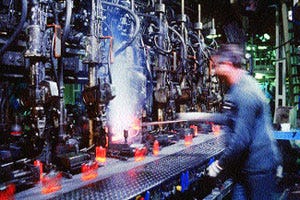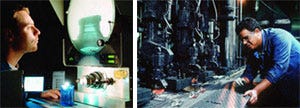January 29, 2014

It is well known that Paris is a mecca of fashion and beauty, with the leading designers of haute couture spreading their influence and name beyond apparel to the world of fragrances and cosmetics. Cartier, Chanel, Christian Dior, Gucci, Guy Laroche, Lancôme, Nina Ricci, Pierre Cardin and Yves Saint Laurent are just a few of the Parisian perfumeries recognized internationally. However, what is probably less well known is that France also leads the world in production of the glass packaging used to hold these fragrances, as well as the perfumes and cosmetics marketed by companies around the world.
Set astride two regions in Northern France, Haute-Normandie (Upper Normandy) and Picardy, the Bresle Valley, which owes its name to the Bresle River that runs through it, is home to 50 companies that together support the production of 75 percent of the world's glass packaging for perfumes and cosmetics. The companies include three model making/design firms, two foundries, 13 mold makers, five glassworks and 27 decorators that employ more than 6,000 workers.
On a recent trip to the area, PACKAGING DIGEST had the opportunity to witness the glass-flask production process in the Bresle Valley firsthand.
Seven centuries of glassmaking
. The Vallèe de la Bresle can trace its lineage in glassmaking back to 1302, when the first glassworks settled near the Lyons forest, or Lyons la Forêt. The forest, one of the largest beech groves in Europe, supplied these early glassmakers with the firewood they needed for their furnaces, as well as with ferns, the ashes of which provided them with the potash necessary for the fusion of sand. At the beginning of the 15th century, the Bresle Valley, and more precisely, the Forest of Eu, became home to a number of glassworks, which for the next 400 years, thrived through their manufacture of window glass and small glassware.
In the 19th century, the glassmakers of the Bresle Valley begin to specialize in flasks for perfumes and cosmetics, as these new markets emerged. The 1800s also saw the replacement of wood with coal for fuel, which resulted in a move by the glassmakers away from the forests and closer to a railway skirting the Bresle River.
In 1921, semi-automatic machines were introduced used compressed air to blow the glass. And, by the 1950s, complete automation of the glassmaking process was made possible with new I.S. (individual section) machines, which are still used today. I.S. machines consist of several sections, each fully functional, that form the containers. The machines, which enabled faster speeds and reduced cost per gross, helped the Bresle Valley step up its production of specialized perfume and cosmetic containers.
In 1999, the Bresle Valley was recognized by the state as an Industrial District, or a Localized Production System, under the Seine-Maritime Economic Development Agency (SME). By enhancing the cooperation and performance of the area's companies, SME largely contributed to the development of an identity for products of the Bresle Valley, establishing the "Valley of Bresle–Glass Valley" label.
In 2001, the Bresle Glass Federation, led by Guy de Vaucorbeil as president, was formed to strengthen export activities, provide networking opportunities, and take advantage of funding from the French government. Today, with yearly sales of more than ?510 million, (U.S. $538 million), the Glass Valley's firms employ 60 percent of the area's workforce.
1.5 billion bottles per year
While the Bresle Valley is home to many businesses with services complementary to glassmaking, the five glass fabrication firms of the valley–of which, Saint-Gobain Desjonquères, Verreries du Courval and Wheaton Glass are the largest–are still the main drivers of the area's glass-production economy. Between the five companies, which comprise four bottlemakers and one producer of drawn-out glass, more than 3,520 of the valley's workers are employed.
|
An operator oversees an I.S. machine as it emits formed glass containers at 900 deg C. |
The behemoth of the glass perfume bottle manufacturers in the Bresle Valley, however, is Saint-Gobain Desjonquères, located in the seaside town of Mers-les-Bains in Picardy. Part of the packaging division of the Saint-Gobain Group, an international business with more than 170,000 employees and ?30.4 billion in net sales in 2001, Saint-Gobain Desjonquères is one of four Saint-Gobain plants worldwide producing specialty bottles and is the largest perfume/cosmetics container factory in the world.
The operation is massive. Spanning more than 100,000 sq m, or nearly 25 acres, the Desjonquères plant is equipped with seven furnaces, feeding two to three I.S. machines each, for an output of around 3.1 million containers/day on 30 lines. According to Thierry Le Goff, director of marketing and sales for the company, 65 percent of the bottles produced are used for fine perfumes, while 35 percent are used in pharmaceutical applications. Of the bottles produced, 80 percent are custom designs, while 20 percent are stock containers.
Astoundingly, Le Goff relates to PD that each year, Saint-Gobain Desjonquères manufactures up to 300 new bottle designs, only 50 of which are carried into the following year. "The life of a product is becoming shorter and shorter," he says. "Consumers are increasingly demanding more-unique products. Only twenty percent of everything produced in the perfume market is a success." Helping its customers–which number more than 1,000 and include names such as Bulgari, Calvin Klein, Cartier, Gucci, Guerlain, Unilever and many others–to differentiate their packaging, the glassmaker offers more than 400 color tints, including red, the hardest to render. Nevertheless, Le Goff says the number-one color choice remains white.
While Saint-Gobain Desjonquères uses the services of model and mold makers in the Bresle Valley region, it also has in-house design and CAD capabilities to produce molds specifically for its machines. "Each glassmaker has its own technology and expertise," says Le Goff. "The mold for a bottle never leaves the building." Each bottle, PD is informed, comprises a mix of nearly 40 different materials, including sand, soda/oxide boron, limestone and others. After being delivered by truck to Saint-Gobain Desjonquères, these materials are weighed and stored until ready for use. From the storage tanks, materials are fed to the blender, where the basic ingredients are mixed, along with any additives or colors. After blending, the mixture is sent to the melting furnace, where it is heated to approximately 1,600 deg C (2,900 deg F) over a period of three days. Says Phillippe Lienard, Saint-Gobain Desjonquères general manager, "The furnaces operate 365 days a year, twenty-four hours a day. We cannot let the melter go cold."
|
Bottles are measured against strict criteria, left, for characteristics such as shape, dimension, wall thickness, inclusions, cracks, internal and external pressure, and others. Quality can also be checked visually, right, as bottles exit I.S. machines, where they are formed by the blow-and-blow or press-and-blow method. |
From the melter, the molten glass then flows into the working chamber, where it rests at a temperature of 1,350 deg C (2,500 deg F) and then flows through the feeder channels, or the forehearth, to the feeders of the I.S. machines. At the Desjonquères facility, two processes are used–blow-and-blow, and press-and-blow–for bottle formation. The former process is accomplished exclusively through the use of compressed air, while the latter uses a metal plunger to press the glass into the desired blank shape, followed by compressed air for final molding. Machines can accommodate from one to four bottles/mold for increased productivity.
Blown-glass containers leaving the I.S. machines have a temperature of 900 deg C (1,650 deg F), and so are very fragile. Thus, they are sent slowly through an annealing lehr by conveyor for cooling.
At the "cold end" of the glassmaking line, finished bottles bound for pharmaceutical uses move through one of two cleanrooms, where video systems methodically check them for characteristics such as shape, dimension, wall thickness, inclusions, cracks, external and internal pressure, and others. Perfume containers, however, are inspected and packed outside of the cleanroom. According to Le Goff, the reject rate for each line averages only 1 percent to 5 percent, with rejects checked every 20 minutes for recurring problems.
For packing finished products into trays and cases, and onto pallets, Saint-Gobain has a virtually endless array of highly automated systems, specially designed to suit all of its customers' preferences. A large part of Saint-Gobain Desjonquères' facility is devoted to warehousing of finished products. Says Le Goff: "Customers usually want only a small amount of bottles at a time, but for us to produce them cost-effectively, we have to run them in large quantities."
Valley of Glass a world leader
To those outside the perfume and cosmetics business, the Bresle Valley may sound like just another quaint destination in scenic France. To those in the know, it is the place where some of the most skilled artisans and operators in glass-making and complementary services can be found. After seven centuries of commitment to the art of glass fabrication, the Valley of Glass has certainly earned its appellation.
In an article to be featured in a subsequent issue, PD will explain how model making/prototyping, mold making and glass decorating fit into the glassmaking process, through a discussion on the operations of three Bresle Valley-based businesses.
More information is available:
Specialty glassmaker: Saint-Gobain Desjonquères, 33 (0)2 35 50 47 00. Circle No. 231.
Association: Bresle Glass Federation, 33 (0)2 32 97 55 40. Circle No. 232.
About the Author(s)
You May Also Like




